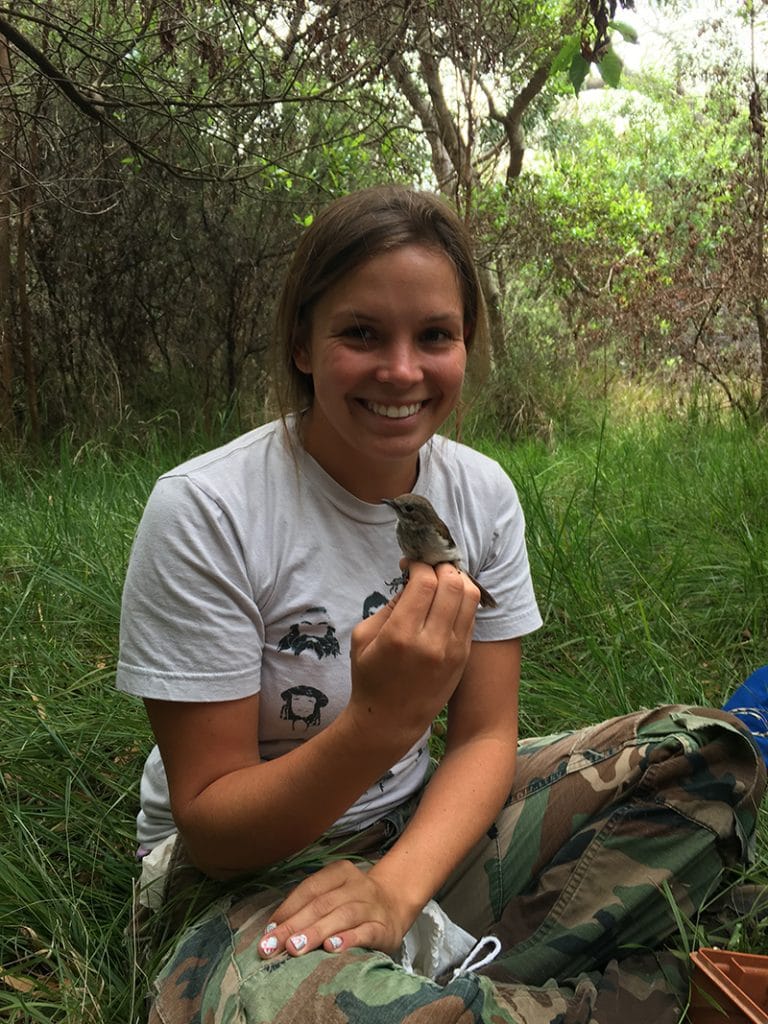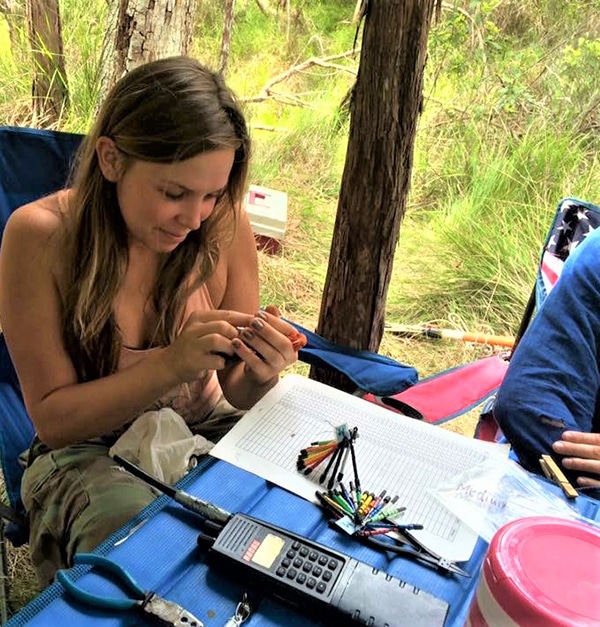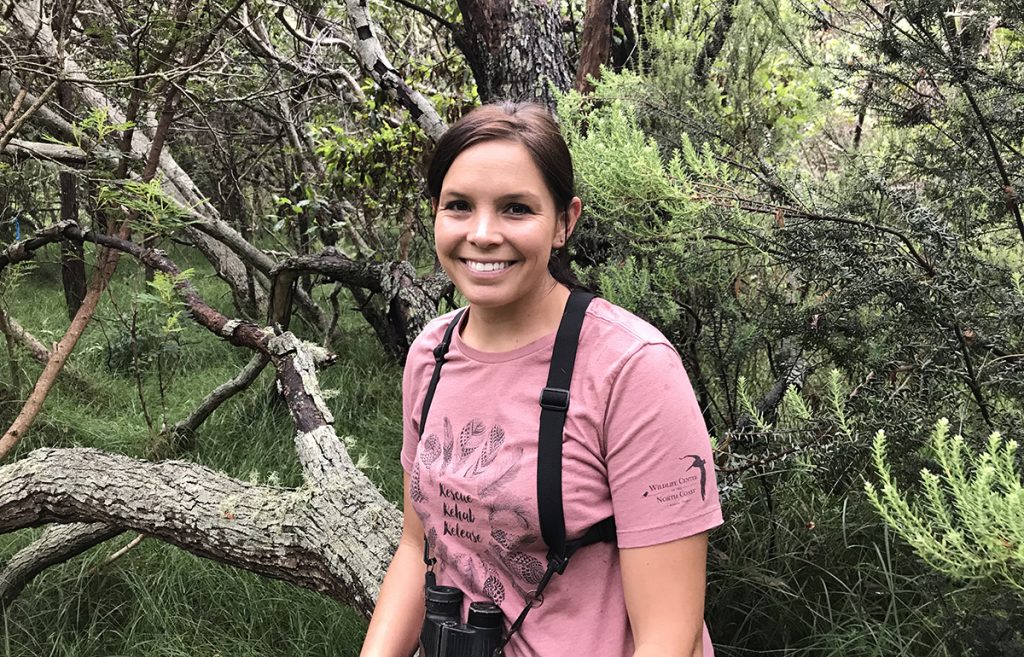A passion for biology has led Kelly Jaenecke from upstate New York to the Pacific Northwest to Hawaiʻi and now to Northern Arizona University. Along the way, she’s studied the effects of non-native predators on native birds, the role of beetles in spreading a deadly forest pathogen and now she’s studying insect-eating Hawaiian birds and their relationship to that same deadly pathogen.
Jaenecke, a master’s student in the Department of Biological Sciences who is doing collaborative work with the Pathogen and Microbiome Institute, is one of four NAU students to be selected for the Graduate Research Fellowship Program (GRFP), which is funded by the National Science Foundation. This three-year program funds the fellows as they conduct research, take courses and work toward their degrees.
For Jaenecke, this fellowship means added freedom to focus on her research, which looks at the diets of insectivorous Hawaiian forest birds. She will use a metabarcoding approach to identify the DNA of prey such as insects, spiders and other arthropods in fecal samples of these birds and will use those data to make comparisons between bird species and habitats over time. Putting the data together will help researchers understand how diet may be impacted by human-caused changes to habitat quality, including the loss of forest to a deadly pathogen.
“I was always interested in pursuing a career in conservation biology, and my experience in Hawaiʻi got me interested more specifically in the ecology and conservation of Hawaiian forest birds, including the ‘elepaio and the Hawaiian honeycreepers,” she said.
Jeff Foster, an associate professor in the Pathogen and Microbiome Institute and Jaenecke’s mentor, said the graduate student brings a mix of hard work, experience and curiosity to her work, which has contributed to her success in the field thus far.
“I appreciate Kelly’s drive, passion for conservation, understanding of the ecology of her study system and her independence,” he said.
Hawaiian research

Jaenecke hasn’t always been focused on the intricacies of changing Hawaiian ecosystems. But she’s always loved exploring the outdoors and observing the life she encountered there.
“As a kid growing up in the Finger Lakes region of New York, I had many opportunities to spend time outside in nature,” she said. “My family went on camping trips to state parks every summer. My dad was a major influence; he would take us on hikes and always encouraged us to explore. He’d show us how to flip logs and rocks to find salamanders, how to find and catch crayfish, and we were always fishing or swimming or hiking and looking for new animals.”
That passion led her to the Big Island of Hawaiʻi, where she found her focus. For the five years she lived and worked there, she was part of a team that studied the impacts of removing black rats, a non-native predator on the nest success of the Hawaiʻi ‘elepaio, a flycatcher (forest bird), which is endemic to the island.
While there, she also investigated the role of ambrosia beetles in spreading Rapid ʻŌhiʻa Death (ROD), a forest pathogen that has killed thousands of acres of ʻōhiʻa trees on Hawaiʻi Island in recent years. Her work also led her to Foster, who encouraged Jaenecke to come to NAU after they discussed potential research projects and their overlapping interest in Hawaiian birds.
“Kelly took the ball and ran with it and has developed a really nice project on the diets of Hawaiian birds whose foraging appears to be affected by a disease that’s killing the native trees,” he said. “Without the trees, there may be far fewer insects upon which the birds can feed. Kelly has set up an elegant experimental design to test the effects of Rapid ʻŌhiʻa Death.”
So, what is ROD, and how will better understanding DNA from birds offer answers about forest health? The disease, which comes from two closely related fungal pathogens, was first reported on Hawaiʻi Island about a decade ago; since then, hundreds of thousands of ʻōhiʻa trees have died as a result. These trees are the most abundant and ecologically important native tree on the island, offering shelter to many native arthropods, which are the primary food source for most native Hawaiian birds.
That means the fungus has already contributed to widespread destruction on the entire ecosystem, and further degradation and loss of native forests could have devastating effects on bird and arthropod communities.
Much of Jaenecke’s research overlaps in this work, while also pulling in factors like human activity. The tiny ambrosia beetle bores into tree trunks to create tunnels or galleries, where they raise their young and grow ambrosia gardens, a non-pathogenic fungus. However, when a gallery penetrates an ROD-infected tree, the boring dust, or frass, expelled from that gallery will contain bits of the ROD fungus, often including spores or viable fragments, which then can become windborne or fall into the dirt and infect other trees, thus spreading the deadly disease more efficiently through the forest.
And, given the connectedness of ecosystems, that’s not the only risk factor. Humans play an indirect role in the spread of the fungus, both through unintentionally moving the infected frass (which sticks to shoes, clothing and vehicles) throughout the island and wounding healthy trees, making them more susceptible to infection.
Jaenecke’s NSF-funded research will use a natural experiment to test the effects of ROD on bird communities, using bird diet and arthropod samples she’s collected in the last decade from sites both before and after ROD was found. The use of bird diet as an indicator of community and ecosystem changes will have wide application in forest health monitoring and food web ecology in a variety of ecosystems.
“Island ecosystems are microcosms of the Earth’s ecosystem but are at a scale that allows for a simpler understanding of the effects of anthropogenic change,” Jaenecke wrote in her research proposal. “The invasion of ROD in Hawaiʻi provides a natural experiment to assesses changes in ecosystem function and biodiversity.”
The GRFP
This was Jaenecke’s second attempt at the GRFP. This time, being enrolled at a program in NAU, she got valuable input and feedback from Foster and others in her research group. Her experience from the first round benefitted as well; reviewer feedback helped Jaenecke in guiding improvements to other parts of the application. She also had a stronger application overall; in the time between applications, Jaenecke authored manuscripts that were published in peer-reviewed journals, gave multiple conference presentations and took a graduate course at the University of Hawaiʻi, Hilo.

She compared the process to applying for graduate school: work history, research experience, college transcripts, publications, awards and presentations are a chunk of it, and each applicant needs a three-page personal statement and a two-page research statement. She had advice for students interested in applying.
- Take advantage of any available opportunities to present research at local or regional conferences. Jaenecke said the feedback she received after her successful application included appreciation for the number of oral and poster presentations and publications.
- Mentor other students. These opportunities, through school or work, demonstrate an applicant’s ability to convey research findings and processes to a wider audience and contribute to community involvement in science.
- Be yourself, highlight your achievements and goals and map out your research proposal so you can express what makes this work worth doing.
- Seek out and incorporate advice and feedback from peers, advisers and mentors.
What’s next
Jaenecke is back in Hawaiʻi for the summer; after a two-week quarantine, she started work with the Hawaiʻi Cooperative Studies Unit (HCSU) in partnership with the U.S. Geological Survey- Pacific Island Ecosystems Research Center (USGS-PIERC), where she worked for five years prior to starting grad school at NAU. Outside of the quarantine, her work hasn’t been affected by the pandemic.
“Hawaiʻi has been my home for the past five years, and I am lucky to be able to jump between here and Flagstaff throughout the year,” she said. “This summer, I won’t be working too closely on my graduate research, but the work is closely related.”
Her research will continue in Hawaiʻi next summer, and Jaenecke wants to continue her research in NAU’s doctorate program in biology. After finishing her education, she hopes to do research at a government agency or a university, with a focus on improving conservation strategies for native species in Hawaiʻi and elsewhere.
Editor’s note: Four NAU students were selected for the National Science Foundation’s Graduate Research Fellowship Program. Learn more about the research of astronomy student Schuyler Borges, geology student Alexis Riche and astronomy post-baccalaureate scholar Jay Kueny.
He Waʻa He Moku, He Moku He Waʻa; the canoe is an island and the island is a canoe; our limited resources need protection and we’re all in this together.
Heidi Toth | NAU Communications
(928) 523-8737 | heidi.toth@nau.edu




